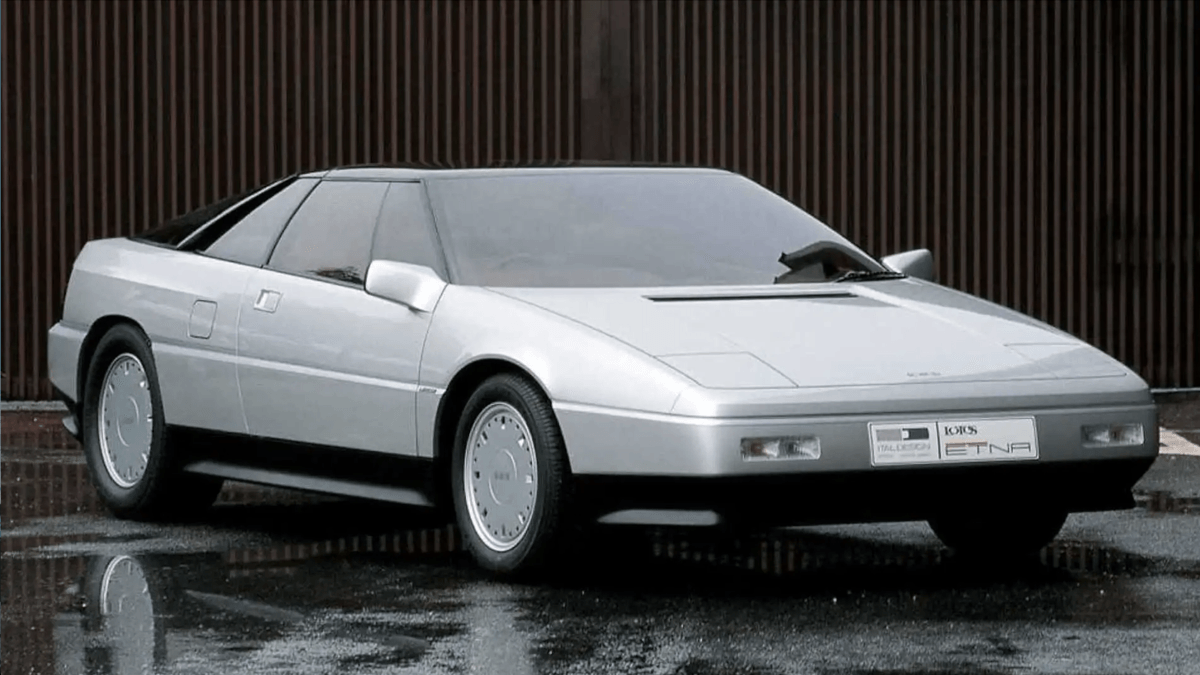Lotus Etna, the car that scared Ferrari and Lamborghini with its V8 engine and pioneering technology, but never reached the market.

In the early 1980s, the once iconic British car industry was in its death throes, unable to compete with the thriving Japanese, German, French, and Italian brands. Lotus immediately understood that the more conventional market was unrecoverable, and if there was any hope of salvation for the Hethel-based company, it lay in the supercar segment, where the aura of Colin Chapman and Lotus Engineering still attracted enthusiasts.
Furthermore, times weren't going well for Ferrari or Lamborghini either, due to an economic crisis that kept sales slow, and Lotus saw in all this an opportunity to fight back. The man tasked with designing what was to be the English supercar of the brand's rebirth was the legendary Giorgetto Giugiaro and his ItalDesign team, whose work had already led to the creation of the Lotus Esprit . Giugiaro knew his rivals very well and their main weakness: their equipment.

Enzo Ferrari was still alive, and the Prancing Horse cars continued to be marked by the Commendatore 's traditional lack of interest in the finish and comfort of his models. He famously said: "I sell engines. I give away the bodywork because the engine has to be mounted somewhere."
The Etna was unveiled at the British International Motor Show in Birmingham and caused a sensation. The brand had applied the latest in F1 technology to the car's profile design. The engine was a 4-liter Type 909 V8, developed by Tony Rudd—the same man responsible for the racing engines—with an aluminum block and electronic control. It was mid-mounted, produced 320 hp, accelerated from 0 to 100 km/h in 4.3 seconds, and was capable of reaching a top speed of 290 km/h.
In terms of numbers, it was 45 hp less powerful than its most powerful rival from Maranello, but that difference wasn't so significant because what really caused panic in Italy was that the Etna was 300 kilos lighter than the Testarossa (1,182 kilos compared to 1,473) and more sophisticated than the Lamborghini Countach . And the slaps to Italian pride didn't end there; the British car's bodywork offered a spectacular aerodynamic coefficient of 0.29, while the Maranello car's was 0.36 and the Sant'Agata's 0.42.

In addition, Giugiaro introduced such advanced technical advances into the car as the active electronic suspension inherited directly from F1, with roll control and automatic leveling, ABS brakes, traction control, and even an active noise cancellation system identical to that used in the company's racing cars.
And without forgetting an interior, comfort, and equipment of another level, while its rivals were still using cranks to raise and lower the windows and cabins, which required contortionism.
On paper, the Etna had everything it needed to become the benchmark for British supercars and appeal to all those wealthy lovers of Aston Martin, Bentley, Jaguar, and other British sports car styles who wanted an alternative to Italian style.
Lotus had even prepared an aggressive launch campaign, but nothing came of it. Neither Lotus itself nor any other manufacturer to whom the project was offered wanted to build the Etna.
The reasons for killing such an advanced car before it was even born remain a great mystery in the industry. Undoubtedly, the rise in fuel prices following the Iran-Iraq War and the death of Colin Chapman in 1982 played a significant role.
Undoubtedly, if the gentleman founder of Lotus - probably the only great constructor who could rival Enzo Ferrari's charisma - had remained alive and personally taken charge of developing his car, the Etna would have been built.
But after Chapman's death, no one at Lotus wanted to step forward and take charge of a project that represented a direct confrontation with the Italians.
And for this to happen, it undoubtedly had a lot to do with the fact that General Motors had already set its sights on Lotus. The American company wanted to buy it—in fact, it acquired it in 1986—and didn't want to be saddled with expensive projects of uncertain success, so it conditioned the future purchase on Lotus abandoning supercars and focusing on more affordable options, such as the 1989 Elan.
On the other hand, an urban legend claims that the all-powerful Enzo Ferrari called each of the heads of his American subsidiary, who also worked with GM, one by one to pressure them, threatening to leave them without cars if GM took over the Lotus Etna. Il Commendatore was certainly tough—as Ford's emissaries experienced firsthand when they sought to buy the company from him—but the veracity of the story has never been confirmed.

The only fully built Etna spent 14 years forgotten in a Hethel warehouse until enthusiast Olav Glasius bought it at auction in 2001. Glasius believed he was acquiring a non-running concept car , but to his surprise, upon opening the fiberglass bonnet, he discovered a Type 909 engine and a perfectly working 5-speed gearbox beneath.
Faced with such a discovery, he hired former Lotus restorer Ken Myers, who managed to get it running by adapting the suspension and missing components from an Esprit. Finally, in 2006, the Etna was able to make its debut at the Lotus Festival at Donington and later made an appearance at the Goodwood Festival of Speed before ending up in a private collection in California.
lavanguardia





